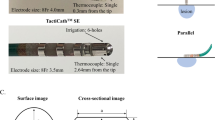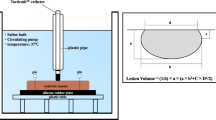Abstract
Radiofrequency, a common ablation modality, is used clinically to terminate cardiac arrhythmias. With excessive heating, complications sometimes occur when the applied energy generates steam pops, which cause release of energy in the form of tissue and/or air emboli. In this study, we investigated numerous parameters potentially associated with intracardiac steam pops including (1) wattage, (2) catheter tip temperature, (3) catheter irrigation, (4) anatomic site, and (5) repeat ablations at a given site. Using unique Visible Heart® methodologies in reanimated swine hearts, we visualized 539 ablations; steam pops developed in 140 of these ablations. The incidence of steam pops significantly increased for both nonirrigated and irrigated ablations at 40 W (p < 0.005), and for nonirrigated ablations with catheter contact angles perpendicular to the tissue or that encompassed larger surface areas (p < 0.05). To minimize the incidence of steam pops, clinicians performing radiofrequency ablations must consider catheter parameters.


Similar content being viewed by others
Abbreviations
- RF:
-
Radiofrequency
References
Go, A. S., Hylek, E. M., Phillips, K. A., et al. (2001). Prevalence of diagnosed atrial fibrillation in adults: national implications for rhythm management and stroke prevention: the Anticoagulation and Risk Factors in Atrial Fibrillation (ATRIA) Study. Journal of the American Medical Association, 285, 2370–2375.
Chun, K. R. J., Brugada, J., Elvan, A., et al. (2016). Cryoballoon or radiofrequency ablation for symptomatic paroxysmal atrial fibrillation: reintervention, rehospitalization, and quality-of-life outcomes in the FIRE AND ICE trial. European Heart Journal, 37, 2858–2865.
Packer, D. L., Kowal, R. C., Wheelan, K. R., et al. (2013). Cryoballoon ablation of pulmonary veins for paroxysmal atrial fibrillation: first results of the North American Arctic Front (STOP AF) pivotal trial. Journal of the American College of Cardiology, 61, 1713–1723.
Cappato, R., Calkins, H., Chen, S. A., et al. (2010). Updated worldwide survey on the methods, efficacy, and safety of catheter ablation for human atrial fibrillation. Circulation. Arrhythmia and Electrophysiology, 3, 32–38.
Haines, D. E. (1993). The biophysics of radiofrequency catheter ablation in the heart: the importance of temperature monitoring. Pacing and Clinical Electrophysiology, 16, 586–591.
Bhaskaran, A., Chik, W., Pouliopoulos, J., et al. (2017). Five seconds of 50-60 W radiofrequency atrial ablations were transmural and safe: an in vitro mechanistic assessment and force-controlled in vivo validation. Europace, 19, 874–880.
Tokuda, M., Tedrow, U. B., & Stevenson, W. G. (2012). Silent steam pop detected by intracardiac echocardiography. Heart Rhythm, 10, 1558–1559.
Juneja, R., & O’Callaghan, P. (2001). Tissue rupture and bubble formation during radiofrequency catheter ablation: “Echoes of a Pop”. Circulation, 103, 1333–1334.
Quallich, S. G., Goff, R. P., & Iaizzo, P. A. (2015). Direct visualization of induced steam pops during radiofrequency ablations. Heart Rhythm Case Reports, 1, 264–265.
Skrumeda, L. L., & Mehra, R. (1998). Comparison of standard and irrigated radiofrequency ablation in the canine ventricle. Journal of Cardiovascular Electrophysiology, 9, 1196–1205.
Yokoyama, K., Nakagawa, H., Shah, D. C., et al. (2008). Novel contact force sensor incorporated in irrigated radiofrequency ablation catheter predicts lesion size and incidence of steam pop and thrombus. Circulation, 1, 354–362.
Cooper, J. M., Sapp, J. L., Tedrow, U., et al. (2004). Ablation with an internally irrigated radiofrequency catheter: learning how to avoid steam pops. Heart Rhythm, 1, 329–333.
Hsu, L., Jaïs, P., Hocini, M., et al. (2005). Incidence and prevention of cardiac tamponade complicating ablation for atrial fibrillation. Pacing and Clinical Electrophysiology, 28, S106–S109.
Chinchoy, E., Soule, C. L., Houlton, A. J., et al. (2000). Isolated four-chamber working swine heart model. The Annals of Thoracic Surgery, 70, 1607–1614.
Laske, T. G., Vieau, S. A., Skadsberg, N. D., & Iaizzo, P. A. (2005). High pacing impedances: are you overtorquing your leads? Pacing and Clinical Electrophysiology, 28, 883–891.
Thompson, N., Lustgarten, D., Mason, B., et al. (2009). The relationship between surface temperature, tissue temperature, microbubble formation, and steam pops. Pacing and Clinical Electrophysiology, 32, 833–841.
Takami, M., Lehmann, H. I., Parker, K. D., Welker, K. M., Johnson, S. B., & Packer, D. L. (2016). Effect of left atrial ablation process and strategy on microemboli formation during irrigated radiofrequency catheter ablation in an in vivo model. Circulation. Arrhythmia and Electrophysiology, 9, e003226.
Nakagawa, H., Imai, S., Arruda, M., et al. (1997). Prevention of pericardial tamponade during radiofrequency ablation of accessory pathways using a saline irrigated electrode. Pacing and Clinical Electrophysiology, 20, 1068 (abstract 75).
De Ponti, R., Cappato, R., Curnis, A., et al. (2006). Trans-septal catheterization in the electrophysiology laboratory: data from a multicenter survey spanning 12 years. Journal of the American College of Cardiology, 47, 1037–1042.
Kuck, K. H., Reddy, V. Y., Schmidt, B., et al. (2012). A novel radiofrequency ablation catheter using contact force sensing: Toccata study. Heart Rhythm, 9, 18–23.
Quallich, S. G., Van Heel, M., & Iaizzo, P. A. (2015). Optimal contact forces to minimize cardiac perforations before, during, and/or after radiofrequency or cryothermal ablations. Heart Rhythm, 12, 291–296.
Pappone, C., Oral, H., Santinelli, V., et al. (2004). Atrio-esophageal fistula as a complication of percutaneous transcatheter ablation of atrial fibrillation. Circulation, 109, 2724–2726.
Siegel, M. O., Parenti, D. M., & Simon, G. L. (2010). Atrial-esophageal fistula after atrial radiofrequency catheter ablation. Clinical Infectious Diseases, 51, 73–76.
Chik, W. W. B., Kosobrodov, R., Bhaskaran, A., et al. (2015). Acoustic signal emission monitoring as a novel method to predict steam pops during radiofrequency ablation: preliminary observations. Journal of Cardiovascular Electrophysiology, 26, 440–447.
Koruth, J. S., Dukkipati, S., Gangireddy, S., et al. (2013). Occurrence of steam pops during irrigated RF ablation: novel insights from microwave radiometry. Journal of Cardiovascular Electrophysiology, 24, 1271–1277.
Tokuda, M., Tedrow, U. B., & Stevenson, W. G. (2013). Silent steam pop detected by intracardiac echocardiography. Heart Rhythm, 10, 1558–1559.
Fassini, G., Conti, S., Pontone, G., Pepi, M., Tondo, C., & Dello Russo, A. (2015). Tissue characteristics and evolution after steam pop. Journal of Interventional Cardiac Electrophysiology, 43, 313.
Acknowledgments
The authors thank Mary Knatterud PhD and Monica Mahre for the technical editing and preparation of this manuscript, as well as Ryan Goff PhD, Megan Schmidt PhD, and Lars Mattison for the technical assistance with the project.
Funding
This research was funded by the Institute for Engineering in Medicine at the University of Minnesota and by a research contract from Medtronic (Minneapolis, MN, USA).
Author information
Authors and Affiliations
Corresponding author
Ethics declarations
Conflict of Interest
The authors declare that they have no conflict of interest.
Disclosures
Paul Iaizzo has a research contract and consultant appointment with Medtronic. Stephen Quallich is currently employed at Medtronic.
Ethical Approval
Human: No human studies were carried out by the authors for this article. Animal: All institutional and national guidelines for the care and use of laboratory animals were followed and approved by the Institutional Animal Care and Use Committee at the University of Minnesota.
Additional information
Associate Editor Ana Barac oversaw the review of this article
Rights and permissions
About this article
Cite this article
Iles, T.L., Quallich, S.G. & Iaizzo, P.A. Identification of Radiofrequency Ablation Catheter Parameters That May Induce Intracardiac Steam Pops: Direct Visualization of Elicitation in Reanimated Swine Hearts. J. of Cardiovasc. Trans. Res. 12, 250–256 (2019). https://doi.org/10.1007/s12265-018-9844-7
Received:
Accepted:
Published:
Issue Date:
DOI: https://doi.org/10.1007/s12265-018-9844-7




